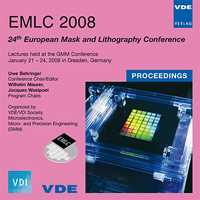Top surface imaging study by selective chemisorptions of poly(dimethyl siloxane) on diazoketo-functionalized polymeric surface
Conference: EMLC 2008 - 24th European Mask and Lithography Conference
01/21/2008 - 01/24/2008 at Dresden, Germany
Proceedings: EMLC 2008
Pages: 12Language: englishTyp: PDF
Personal VDE Members are entitled to a 10% discount on this title
Authors:
Ganesan, Ramakrishnan; Youn, Seul Ki; Yun, Jei-Moon; Kim, Jin-Baek (Department of Chemistry and School of Molecular Science (BK21), Korea Advanced Institute of Science and Technology (KAIST), 373-1, Guseong-Dong, Yuseong-Gu, Daejeon, 305-701, Republic of Korea,)
Abstract:
Top surface imaging (TSI) techniques using vapor or liquid phase silylation have been investigated extensively as alternatives to conventional resist processing. However, earlier imaging schemes such as diffusion enhanced silylated resist (DESIRE) and digital top surface imaging showed several difficulties limiting the successful application of such TSI approaches. In the case of DESIRE, additional CF4 plasma descum process was required to remove the thin layer of Si incorporated into the cross-linked regions, as some of the Si remained even in the unexposed regions. Also, difference in the cross-linking density and subsequent amount of silicon incorporation across the width of an optically projection printed feature led to non-uniform silylation profiles resulting the difficulty with critical dimension (CD) control of the feature and increased the LER of the overall process. In the case of digital TSI, even though it was developed to overcome these problems with the cross-linking-based silylation process, the concentration of active sites in the exposed polymer varies across the feature width due to the non-uniform energy deposition profile across a feature which results from the non-ideal aerial image produced using optical projection tools. In this study, we have used a diazoketo-functionalized polymer as the platform for the immobilization of amine-functionalized poly(dimethyl siloxane) (amine-PDMS). The diazoketo functional groups undergo Wolff rearrangement to generate carboxylic acid groups upon UV light exposure. This chemistry is exploited to create alternate hydrophilic/hydrophobic patterned regions by selective UV light exposure. The hydrophilic regions that contain carboxylic acid groups predominantly are further used to immobilize amine-PDMS by amide bond formation using carbodiimide coupling chemistry. Due to the high silicon content, the immobilized PDMS acts as the etch barrier for the subsequent oxygen plasma reactive ion etching (O2-RIE) process. Thus, a negative-tone pattern has been successfully generated using O2-RIE process. An amine-PDMS with a molecular weight of 900 was used in this study. Auger electron spectroscopy was employed to characterize the immobilization of amine-PDMS onto UV light exposed regions of diazoketo-functionalized polymer surface. Atomic force microscopy was used to study the surface smoothness after O2-RIE process. Scanning electron microscopy was used to image the pattern profiles formed after O2-RIE process. High resolution pattern profiles are obtained using the TSI process reported in this study.


